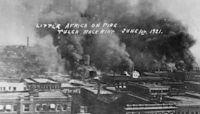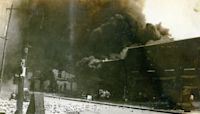Search results
- Tulsa Race Massacre - What You Need to Know
The Tulsa race massacre, also known as the Tulsa race riot or the Black Wall Street massacre, was a two-day-long white supremacist terrorist massacre that took place between May 31 and June 1, 1921, when mobs of white residents, some of whom had been appointed as deputies and armed by city government officials, attacked black residents and ...
- Tulsa's Black Wall Street
- What Was The Tulsa Race Massacre?
- Greenwood Burns
- How Many People Died in The Tulsa Race Massacre?
- News Blackout
- Tulsa Race Riot Commission Established, Renamed
- Sources
In much of the country, the years following World War I saw a spike in racial tensions, including the resurgence of the white supremacist group the Ku Klux Klan, numerous lynchings and other acts of racially motivated violence, as well as efforts by African Americans to prevent such attacks on their communities. By 1921, fueled by oil money, Tulsa ...
On May 30, 1921, a young Black teenager named Dick Rowland entered an elevator at the Drexel Building, an office building on South Main Street. At some point after that, the young white elevator operator, Sarah Page, screamed; Rowland fled the scene. The police were called, and the next morning they arrested Rowland. By that time, rumors of what su...
After shots were fired and chaos broke out, the outnumbered group of Black men retreated to Greenwood. Over the next several hours, groups of white Tulsans—some of whom were deputized and given weapons by city officials—committed numerous acts of violence against Black people, including shooting an unarmed man in a movie theater. The false belief t...
In the hours after the Tulsa Race Massacre, all charges against Dick Rowland were dropped. The police concluded that Rowland had most likely stumbled into Page, or stepped on her foot. Kept safely under guard in the jail during the riot, he left Tulsa the next morning and reportedly never returned. The Oklahoma Bureau of Vital Statistics officially...
For decades, there were no public ceremonies, memorials for the dead or any efforts to commemorate the events of May 31-June 1, 1921. Instead, there was a deliberate effort to cover them up. The Tulsa Tribuneremoved the front-page story of May 31 that sparked the chaos from its bound volumes, and scholars later discovered that police and state mili...
The following year, after an official state government commission was created to investigate the Tulsa Race Riot, scientists and historians began looking into long-ago stories, including numerous victims buried in unmarked graves. In 2001, the report of the Race Riot Commission concluded that between 100 and 300 people were killed and more than 8,0...
James S. Hirsch, Riot and Remembrance: The Tulsa Race War and Its Legacy (New York: Houghton Mifflin, 2002). Scott Ellsworth, “Tulsa Race Riot,” The Encyclopedia of Oklahoma History and Culture. 1921 Tulsa Race Riot, Tulsa Historical Society & Museum. Nour Habib, “Teachers talk about how black history is being taught in Oklahoma schools today,” Tul...
6 days ago · The Tulsa race massacre of 1921 was one of the most severe incidents of racial violence in U.S. history. It occurred in Tulsa, Oklahoma. Beginning on May 31, 1921, and lasting for two days, it left between 30 and 300 people dead, mostly African Americans, and destroyed Tulsa’s prosperous Black neighborhood Greenwood.
- The Editors of Encyclopaedia Britannica
May 24, 2021 · The Tulsa Race Massacre of 1921 killed hundreds of residents, burned more than 1,250 homes and erased years of Black success.
May 30, 2021 · The Tulsa Race Massacre stands out as one of the worst acts of racial violence in American history—and, for decades, it remained one of the least known. Over the course of 18 hours, from May 31...
Tulsa Race Massacre, 1921 (1619126, Oklahoma Historical Society Photograph Collection, OHS). Standpipe Hill destruction (image courtesy of OSU Digital Collections). State Troops Deployed. Deployed at 10 p.m. the night before, one hundred Oklahoma City National Guard troops made their way to Tulsa.
The name Greenwood still evokes the possibilities and history of Black entrepreneurship, but talk of the 1921 Tulsa Race Massacre reminds the world of the centuries-long struggle of Black people against white mob violence and its greenlighting from white authorities.




